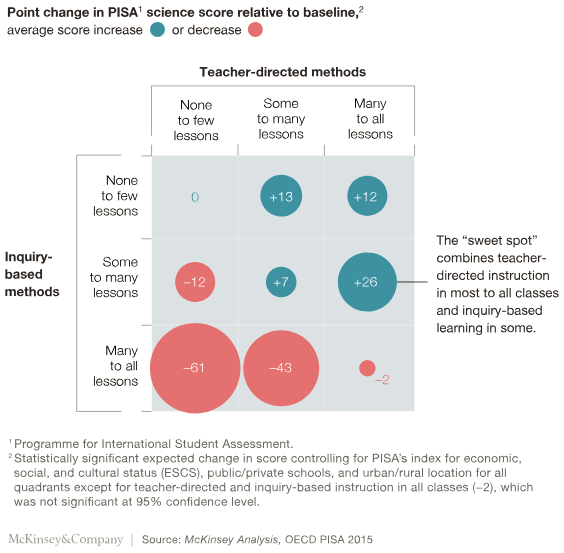Putting Students on the Path to Learning by Richard Clark, Paul Kirschner and John Sweller.
|
I recently saw this clip of John Hattie speaking about Inquiry Learning, and why it has such a low effect-size in comparison to some of the other aspects he has looked at in Visible Learning. This is something that has intrigued me since first reading his work, as we clearly want our students to develop into effective inquirers, so why is it that using this approach is not more effective?
I think he perfectly sums up one of the main problems with teaching solely through inquiry, which is that in order to inquire about something, you have to know something to start with. This links to some of the other reading I have done, particularly on the ideas of Critical Thinking and Creativity being domain specific skills, and that in order to develop these skills you need to know a lot about the domain in which you want to apply them.
For example, I am a good critical thinker in mathematics, and am a pretty creative mathematician. I am able to use methods to solve problems that those with less knowledge of maths would not be able to do, even if they knew the methods. But I am a novice photographer (something I am learning at the moment). I am unable (at this stage) to think critically about the lighting of my photos, and be creative with my compositions, when taking photos, even though I know this is what I want to do. It is not through lack of trying, but rather that my knowledge is still relatively low in the domain of photography, and I am having to think about the technicalities of the photography, which would be automatic to an expert photographer.
The same is true of inquiry. I am very capable of inquiring and discovering new mathematical ideas, and I am quite quick at being able to apply these ideas to solving other problems. But in photography, my attempts at new styles are often disappointing until I have some instruction in how to approach them (usually from a Youtube video, or blog post). Even though I have a macro lens, I have never been able to take a macro shot that is a good photo, because I have not invested the time in being properly instructed in how to use it, nor have I then practiced enough at this skill to become better at it, and I will improve very slowly if left to my own devices to play around with the lens.
This chimes with the recent findings from the PISA 2015 data that show that the "sweet spot" for teaching is using teacher directed instruction in most to all lessons, and inquiry in some lessons (https://www.mckinsey.com/industries/social-sector/our-insights/how-to-improve-student-educational-outcomes-new-insights-from-data-analytics).
And this brings us back to what Hattie was saying in the clip. No, the low effect size for inquiry learning is not telling us to never do inquiry based learning. It is saying that we should save inquiry for the right time in the learning journey. And this is not at the start, but rather after we have developed a strong foundational base of knowledge and skills. At this stage, inquiry can help us extend and consolidate our learning in an area, but relying too heavily on inquiry in the initial stages of instruction can lead to more problems later on.
Perhaps counter-intuitively, the best way to develop students as enquirers is not to give them lots of practice at inquiry, but rather develop a strong foundational knowledge base, from which they can then base further inquiry.
Perhaps in a few years I will be able to develop new photography skills "on the fly", by trying things out. But for now, I will continue to rely on some instruction from my internet sources!
Suggested Further Reading
Putting Students on the Path to Learning by Richard Clark, Paul Kirschner and John Sweller.
0 Comments
Your comment will be posted after it is approved.
Leave a Reply. |
Dan Rodriguez-Clark
I am a maths teacher looking to share good ideas for use in the classroom, with a current interest in integrating educational research into my practice. Categories
All
Archives
August 2021
|

 RSS Feed
RSS Feed
